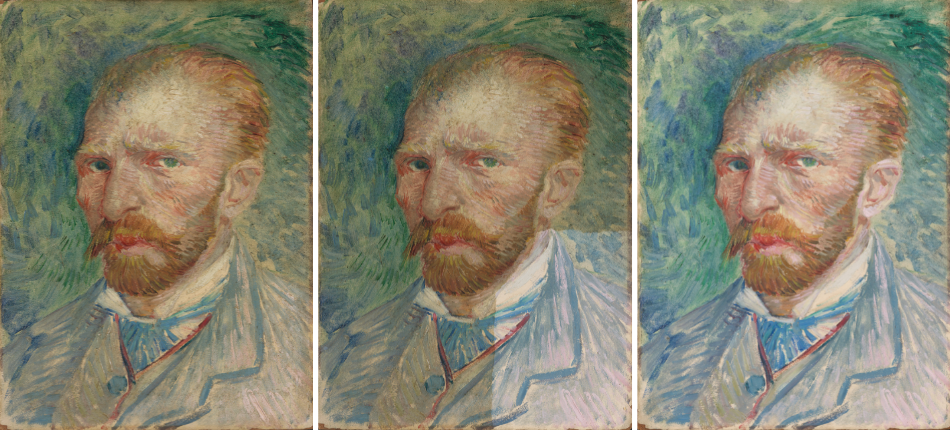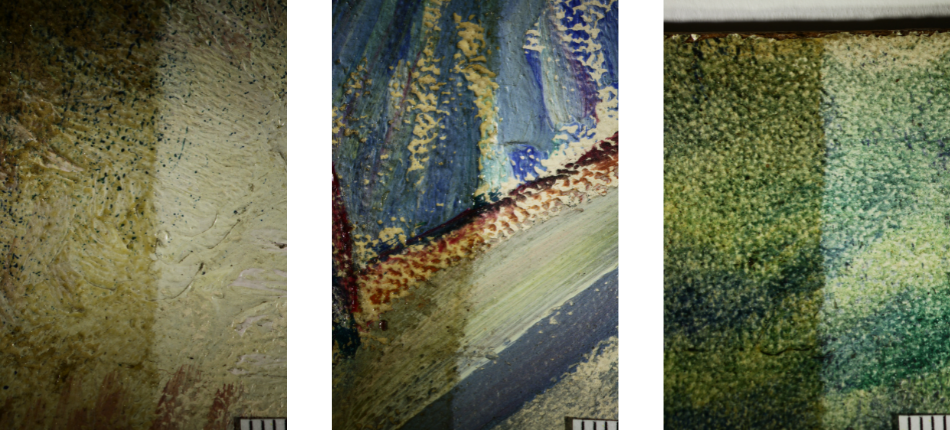Vincent van Gogh’s Self-portrait is a much-loved masterpiece and the only self-portrait by Van Gogh in the museum’s collection. It was purchased by Helene Kröller-Müller on 11 February 1919 (her birthday) for 6,500 guilders from the Amsterdam auction house Frederik Muller. The painting came from the collection of Carl Sternheim, one of Germany’s most ardent admirers of Van Gogh.
Paris
Van Gogh painted the work in Paris, where he stayed from March 1886 to 19 February 1888. He created about 25 self-portraits while in Paris, probably in part because he could not afford models. The lack of money is presumably also the reason why he painted this portrait not on canvas, but on the less expensive cardboard. Van Gogh has used diluted oil paint for the background, which almost gives the impression of a watercolour.
The original colouration has unfortunately been lost. Organic red pigments in both the background and the jacket have discoloured through exposure to light. The original, much warmer, more purple hue is still visible along the edges of the painting, which were protected from light by the rabbet of the frame.
Nevertheless, it is still apparent that Van Gogh gave up his sombre ‘Dutch’ palette while in Paris, in favour of the bright tones of the French impressionists.
Urgency
The Self-portrait has likely received conservation treatment in the past, a long time ago. A non-original varnish was then removed and replaced with a new, now severely yellowed varnish.
In 2020, a condition study was carried out and a detailed condition report produced. The conclusion was that the conservation treatment should no longer be postponed.
An important reason for this was that the yellowed and glossy varnish on the painting fails to do justice to the image that Van Gogh had intended.
Secondly, the framing had to be improved to limit the damage to the fragile edges of the cardboard and to the paint and ground layer. The greatest risk of damage to the edges occurs during the framing and unframing of the painting. The painting had, therefore, not been removed from its frame since 2014 and no varnish removal tests were carried out for the same reason.
The conservation
During the conservation, the varnish was removed, the paint and cardboard were locally consolidated, and losses in the paint layer were filled and retouched. Although the partly matt paint layers were originally unvarnished, a very small amount of varnish was applied during the conservation, to give the darker sections in particular a little more saturation.
The painting on cardboard has been reversibly mounted on a slightly larger cardboard backing. It can now be handled safely, as it is no longer necessary to touch the fragile cardboard. Moreover, when the painting is in its frame, there is no longer any pressure on the vulnerable edges of the cardboard.

Execution
The conservation was carried out by Margje Leeuwestein, painting conservator at the Kröller-Müller Museum, and independent paper conservator Marieke Kraan. Because the Self-portrait is painted on cardboard, advice was sought from a paper conservator regarding the organic solvents for removing the varnish and the appropriate method for locally consolidating the fragile cardboard. The method of framing was also selected in consultation with Marieke Kraan and she carried out the reversible mounting of the cardboard on the backing cardboard.
The total cost was € 12,500.
The Self-portrait before, during and after conservation / Microscope images of, respectively, the forehead, waistcoat and tie and the background (centre top edge) during varnish removal. On the right, the yellowed and soiled varnish has been removed. The distance between the black lines on the ruler corresponds to 1 millimetre in reality.


